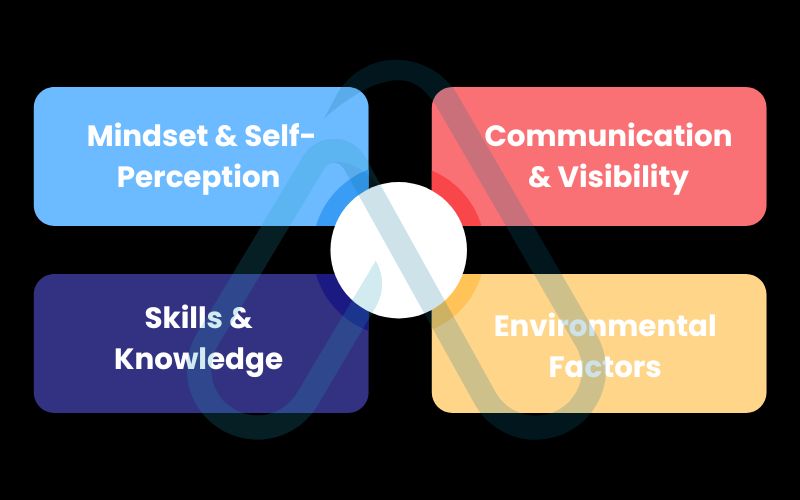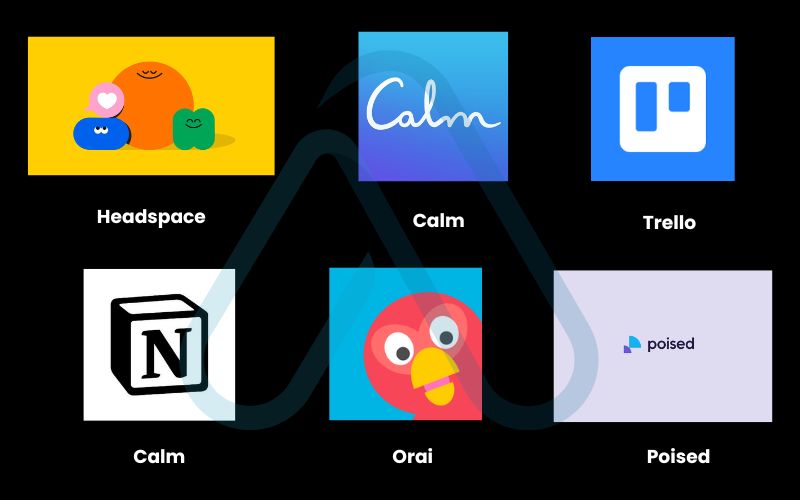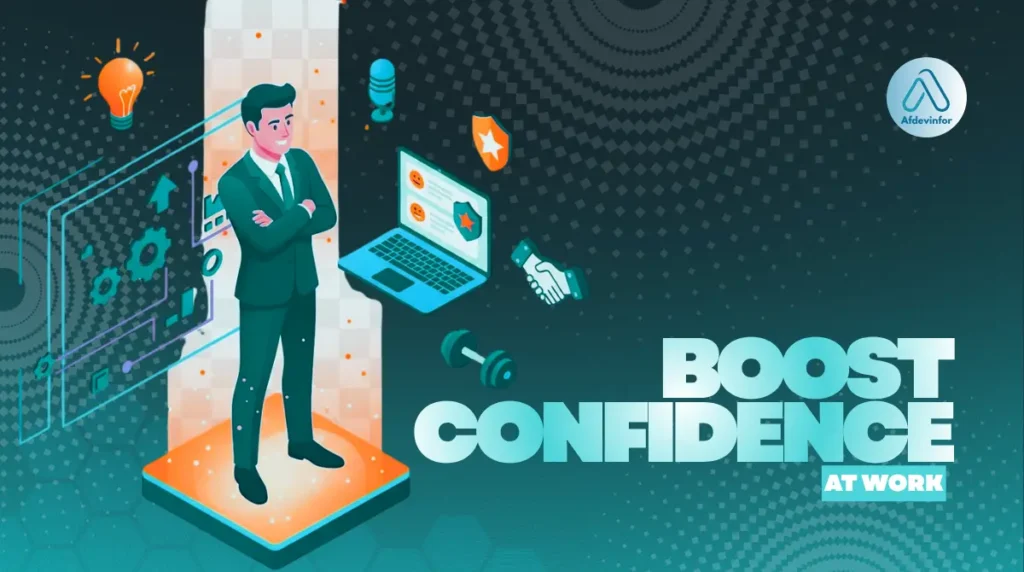Confidence isn’t something you’re simply born with it’s something you build. In today’s fast-paced and competitive workplace, knowing how to boost confidence at work can be the difference between feeling stuck and stepping into your full potential. This guide goes beyond the surface-level “fake it till you make it” advice, offering a structured, evidence-based approach to genuine self-assurance.
Before we dive in, here’s a quick overview of what you’ll learn inside this comprehensive guide:
- Understand the root causes of self-doubt and why confidence issues often stem from both internal and external factors.
- Conduct your own ‘Confidence Audit’ to identify where your biggest growth opportunities lie.
- Rewire your mindset with proven techniques like cognitive reframing and success journaling.
- Build confidence through action with assertive communication, boundary-setting, and strategic visibility.
- Leverage digital tools to reinforce new habits and maintain momentum in your professional growth.
- Learn from real professionals who’ve overcome imposter syndrome, bias, and remote work challenges.
By the end of this guide, you’ll have a practical roadmap to strengthen your confidence from the inside out and the tools to sustain it long term.
1. A new blueprint for workplace confidence
Feeling like you’re playing a part at work instead of being your most effective self? You’re not alone. After more than a decade in tech, I’ve seen countless brilliant people held back by self-doubt. That’s why I’ve developed this guide on how to boost confidence at work, moving beyond the tired advice of ‘fake it till you make it.’ We’ll explore a holistic approach that blends actionable psychology, tech-enabled tools, and inclusive strategies tailored for the modern professional. This isn’t about generic tips; it’s a structured path to genuine self-assurance.
“Confidence is a skill, not a personality trait. It’s a muscle you can build through consistent, intentional practice.”
Throughout this article, we’ll walk through my complete confidence-building framework. We’ll start with a personal ‘Confidence Audit’ to pinpoint your unique challenges. Then, we’ll dive into rewiring your Internal Mindset and implementing powerful External Strategies. Finally, I’ll share my curated Tech Toolkit to help you reinforce these new habits. Let’s get started.
2. Understanding the root causes of self-doubt at work
Before we can build new habits, we have to understand what’s undermining our confidence in the first place. Answering the question, ‘What causes lack of confidence in the workplace?’ is a critical diagnostic step. In my experience, the root causes are rarely simple and usually fall into two distinct categories: internal triggers and external pressures.
2.1. The internal monologue: Mindsets that hold you back
Often, the biggest obstacle is the voice inside our own heads. These are common thought patterns, not personal failings, that can quietly erode our self-belief. Here are a few I see most often:
- Imposter Syndrome: This is the persistent, nagging feeling that you’re a fraud and will be ‘found out,’ despite clear evidence of your skills and accomplishments. It convinces you that your successes are due to luck, not ability.
- Perfectionism: The belief that anything short of flawless is a failure. This mindset makes you overly critical of your work, afraid to take risks, and can lead to procrastination for fear of not meeting impossibly high standards.
- Negative Self-Talk: This is the habit of being your own harshest critic. An internal monologue filled with phrases like ‘I can’t do this’ or ‘I’m not smart enough’ directly chips away at your self-worth and ability to perform.
2.2. When the workplace is the problem
Sometimes, the issue isn’t you, it’s your environment. A challenging or unsupportive workplace can crush the confidence of even the most competent professional. It’s crucial to recognize these external factors.
These pressures can include toxic leadership that rules by fear, a lack of psychological safety where asking questions or admitting mistakes is punished, subtle microaggressions that make you feel like an outsider, and unclear expectations that leave you constantly guessing if you’re doing a good job. Overcoming self-doubt at work becomes nearly impossible when the system itself is the source of the problem.
| A Critical Note: Your lack of confidence may not be a ‘you’ problem; it could be a signal of an unhealthy work environment. Recognizing this distinction is the first step toward empowerment. |
3. Your personalized self-assessment
To create a targeted plan, we first need a clear diagnosis. I developed this ‘Confidence Audit’ as a practical, no-judgment tool for self-discovery. Take a moment to honestly reflect on these questions. Your answers will help you identify which sections of this guide will be most impactful for you.
As you read, mentally check off the questions that resonate most with you. Keep your results in mind as we move into the solutions-focused sections.
Part 1: Mindset & Self-Perception
- Do I frequently attribute my successes to luck rather than my own skills?
- Do I hesitate to take on new challenges for fear of not performing perfectly?
- Is my internal monologue more critical than encouraging?
Part 2: Skills & Knowledge
- Do I feel my skills are outdated or insufficient for my role?
- Do I avoid tasks where I feel my knowledge is weak?
- Do I compare my skill set unfavorably to my colleagues?
Part 3: Communication & Visibility
- Do I avoid speaking up in meetings, even when I have a valuable idea?
- Do I find it difficult to say ‘no’ or set boundaries with my workload?
- Do I struggle to articulate my achievements to my manager?
Part 4: Environmental Factors
- Do I feel psychologically safe to make mistakes or ask for help on my team?
- Does my manager provide clear, constructive feedback?
- Do I feel seen, heard, and valued within my workplace culture?

4. Evidence-based strategies for internal confidence
Now that you have a better understanding of your specific challenges, let’s focus on the internal game. Building genuine, lasting self-confidence at work starts from within. These are a few of my go-to, evidence-based techniques that serve as excellent professional development tips for rewiring your brain for self-assurance.
4.1. The cognitive reframing technique from critic to coach
Cognitive reframing is a powerful technique from cognitive-behavioral therapy that helps you change your perspective on a situation. It’s about learning to identify, challenge, and replace your automatic negative thoughts with more balanced and constructive ones. It’s a direct antidote to overcoming self-doubt at work. Here’s how to do it:
I’ve put together a simple table to show this process in action.
| Negative Thought (Critic) | Challenge Question | Reframed Thought (Coach) |
|---|---|---|
| “I completely failed that presentation.” | “Is that 100% true? What parts went well? What is one thing I can improve next time?” | “That presentation wasn’t my best, but I explained the data clearly. Next time, I will practice the Q&A section more thoroughly.” |
| “Everyone on my team knows more than I do.” | “What unique skills or perspective do I bring? Is it a competition, or are we a team?” | “My teammates have deep expertise in some areas, and I bring a fresh perspective and strong skills in others. I can learn from them.” |
4.2. Create a ‘success file’ to combat imposter syndrome
Imposter syndrome thrives on feelings and ignores facts. The best way to fight it is with cold, hard evidence of your competence. That’s where a ‘Success File’ comes in. This is a dedicated space, either digital or physical, where you actively document your achievements, big and small. This practice provides concrete proof to silence your inner critic. I suggest you update it weekly. Here are some ideas for what to include:
- Project milestones you met or exceeded.
- Positive feedback from emails, chat messages, or performance reviews.
- A new skill you learned or a tough problem you solved.
- Client compliments or testimonials.
- Anytime you successfully helped a colleague.
4.3. Master your body language to project confidence
Your physiology has a direct impact on your psychology. Research shows that adopting more confident body language can actually make you feel more self-assured. It’s a two-way street: feeling confident improves your posture, and improving your posture can boost your confidence. Here are a few small changes that make a huge difference in meetings and presentations:
- Maintain eye contact: It signals honesty and engagement.
- Keep an open posture: Avoid crossing your arms, which can appear defensive. Keep your shoulders back and your head held high.
- Use purposeful gestures: Use your hands to emphasize points, which makes you appear more dynamic and certain.
- Take up space: Sit or stand in a way that is relaxed and open, not hunched or constricted.

5. Building confidence in your work environment
Mindset work is the foundation, but confidence is ultimately built through action. This section is about offense, actively shaping your professional reality through your behaviors and communication. This is how you start building credibility in teams and demonstrating your value in a tangible way.
5.1. How to speak up without being aggressive
One of the most powerful assertiveness skills you can develop is clear, respectful communication. Assertiveness is the healthy middle ground between passivity (not speaking up) and aggression (speaking up in a hostile way). It’s about expressing your needs and opinions while respecting others. A simple framework I teach is the ‘I-Statement.’ It looks like this:
“I feel [your emotion] when [the specific behavior happens] because [the impact on you]. I would appreciate it if [your requested change].”
For example, instead of silently fuming about a colleague who interrupts you, you could say:
“I feel frustrated when I’m interrupted in meetings because it makes it hard for me to finish my thought. I would appreciate it if I could complete my point before we move on.”
5.2. Navigating external challenges: Handling bias and toxic managers
I want to be clear: dealing with a toxic environment or systemic bias is incredibly difficult and emotionally taxing. The goal here is not to ‘fix’ a broken system but to protect your well-being and confidence while navigating it. Your safety and mental health must always come first.
| Your Safety Comes First: The following advice is for navigating difficult situations. If you feel you are in a hostile or unsafe environment, your priority should be to consult with HR, a trusted mentor, or seek external support. |
In these situations, focus on what you can control. Meticulously document incidents with dates, times, and specifics. Set firm boundaries on your time and workload to prevent burnout. Build a network of trusted allies and mentors who can offer support and perspective. This isn’t an easy path, but taking these protective actions is an empowering act in itself.
5.3. Building confidence in remote work from isolated to integrated
Remote work presents its own unique confidence challenges, primarily around visibility and connection. When you’re not physically present, you have to be more intentional about demonstrating your value and building relationships. Here is my go-to remote confidence checklist:
- Communicate Proactively: Don’t wait to be asked for an update. Send regular, concise summaries of your progress on key projects.
- Be Visible in Digital Channels: Actively participate in your team’s chat channels. Ask thoughtful questions, share relevant articles, and publicly acknowledge the good work of others.
- Schedule Virtual ‘Coffee Chats’: Set aside 15-20 minutes for informal, non-work-related video calls with colleagues. This is crucial for building the personal rapport that happens naturally in an office.
- Master Your Virtual Presence: Ensure you have good lighting and a clear audio setup for video calls. When you speak, look at the camera to simulate eye contact.
6. How to boost confidence at work with digital routines
As a technology expert, I firmly believe in leveraging tools for employee empowerment. The right apps and digital routines can reinforce the mindset and behavioral shifts we’ve discussed, making it easier to build and maintain confidence. Here are a few of my top recommendations, categorized by function.
6.1. For mindfulness and focus: Headspace, Calm
Confidence is often rattled by anxiety and stress. Mindfulness apps like Headspace and Calm are phenomenal for managing this. They teach you to observe your thoughts without judgment, which is a core skill for handling negative self-talk. I often recommend my clients use a 5-minute guided meditation for focus right before a big presentation. It’s incredibly effective at calming nerves and sharpening your mental state.
6.2. For tracking achievements: Trello, Notion, or a simple digital journal
These tools are the perfect digital home for your ‘Success File.’ Instead of a dusty document, you can create a dynamic, visual record of your accomplishments. For example, you can create a simple Trello board with columns for ‘To Do,’ ‘Doing,’ and ‘Done.’ Over time, your ‘Done’ column becomes a powerful, scrollable testament to your capabilities that you can review anytime you feel a bout of imposter syndrome creeping in.
6.3. For practicing communication: Orai, Poised
Public speaking is a major source of anxiety for many, but technology now offers a private, judgment-free way to practice. AI-powered communication coaches like Orai and Poised can analyze your speech during video calls or practice sessions. They provide objective feedback on your pace, use of filler words (like ‘um’ and ‘ah’), and clarity. Improving these mechanics is a direct and measurable way to boost your speaking confidence.
| A Modern Approach: Using AI tools to get objective feedback on your communication is a cutting-edge strategy that accelerates skill development and provides a massive confidence boost before important meetings. |

7. Spotlights from the modern workplace
Theory is important, but stories are what make these strategies real. To add more depth, I’ve gathered insights from professionals who have successfully navigated their own confidence journeys. Their experiences add a layer of credibility and relatability that I find incredibly valuable.
7.1. Overcoming imposter syndrome as a junior developer
I spoke with a junior software developer who, despite being a top performer in his coding bootcamp, felt like a complete fraud in his first job. He was convinced he didn’t belong. He overcame this by implementing a three-part strategy: he found a senior developer to be his mentor, he started a daily log of one new thing he learned, and he began making small contributions to an open-source project.
“The open-source work was key,” he told me. “It gave me a tangible, public record of my skills. I could literally point to it and say, ‘I built that.’ It was undeniable proof that I wasn’t an imposter.”
7.2. Navigating bias as a woman in tech
A director of engineering I know shared her experience with building confidence while facing systemic bias. Early in her career, her ideas were often ignored in meetings, only to be praised when a male colleague repeated them moments later. Her solution was multi-faceted and strategic.
“I built a coalition of other women and allies,” she explained. “We made a pact to amplify each other’s voices. If one of us made a good point, another would immediately say, ‘That’s a great idea, Sarah. Let’s explore that further.’ It made our contributions impossible to ignore. I also became meticulous about documenting my team’s wins and tying them directly to business outcomes in my reports.”
7.3. Thriving in a collaboration-heavy culture for the introvert
Finally, I connected with a data analyst who described himself as deeply introverted. The constant pressure to brainstorm and collaborate in large, loud group settings was draining his confidence. He learned to thrive not by trying to become an extrovert, but by leveraging his introverted strengths.
He would prepare his thoughts and data points thoroughly before meetings, allowing him to contribute concisely and with great impact. He also found that he excelled at building deeper one-on-one relationships and communicating thoughtfully over email and chat, which ultimately built his reputation as a reliable and insightful expert.
8. FAQs about how to boost confidence at work
Here are concise answers to some of the most common questions I receive about building workplace confidence. For a deeper dive, I’ve referenced the relevant sections within the article.
How can I improve my confidence at work quickly?
Try a 2-minute power pose before stressful situations, prepare one talking point or question for your next discussion, and wear something that makes you feel capable.
How do I overcome imposter syndrome at work?
Normalize the feeling, reframe negative thoughts, and keep a detailed “Success File” of achievements to counter emotion with evidence.
What are signs of low confidence in employees?
Avoiding eye contact, hesitant language, difficulty accepting praise, not sharing ideas, and over-apologizing.
Can confidence be learned or is it innate?
Confidence is learnable. The brain can build it over time through practice (neuroplasticity).
Glossary of key terms
| Term | Full Term / Concept | Meaning |
|---|---|---|
| AI | Artificial Intelligence | The simulation of human intelligence in machines, particularly computer systems. In this context, used for tools that analyze and provide feedback on communication skills. |
| Cognitive Reframing | Cognitive Reframing | A psychological technique used to identify and then dispute irrational or unhelpful thoughts. It involves changing one’s perspective to see a situation in a more positive or realistic light. |
| Imposter Syndrome | Imposter Syndrome | An internal psychological pattern in which an individual doubts their skills, talents, or accomplishments and has a persistent internalized fear of being exposed as a ‘fraud’. |
| Microaggressions | Microaggressions | Subtle, often unintentional, comments or actions that express a prejudiced attitude toward a member of a marginalized group. |
| Neuroplasticity | Neuroplasticity | The brain’s ability to reorganize itself by forming new neural connections throughout life. This allows the brain to adapt, learn, and change in response to experience. |
| Psychological Safety | Psychological Safety | A shared belief held by members of a team that the team is safe for interpersonal risk-taking. It’s a sense of confidence that the team will not embarrass, reject, or punish someone for speaking up. |
9. Final thoughts
Building genuine, lasting confidence is not about a single quick fix. As I’ve outlined, it’s a holistic journey that requires tending to your internal mindset, taking strategic external actions, and leveraging the right tools to support your growth. Remember that this is a process, and every small step forward is a victory. The goal is progress, not perfection.
To summarize, here are the most critical takeaways from this guide:
- Diagnose First: Use the ‘Confidence Audit’ to understand whether your challenges are primarily internal, external, or a mix of both.
- Separate Facts from Feelings: Combat imposter syndrome and negative self-talk with concrete evidence by keeping a ‘Success File’ of your accomplishments.
- Act Your Way into Feeling: Confidence is built through action. Practice assertiveness, master your body language, and be proactive in your communication.
- Leverage Technology: Use modern tools for mindfulness, achievement tracking, and communication practice to accelerate your progress.
Your journey to greater confidence starts now. Take the first step.
At Afdevinfo, my goal is to provide supportive guidance you can apply immediately to improve your work life. For more in-depth guides on professional development, explore our Career Development.


